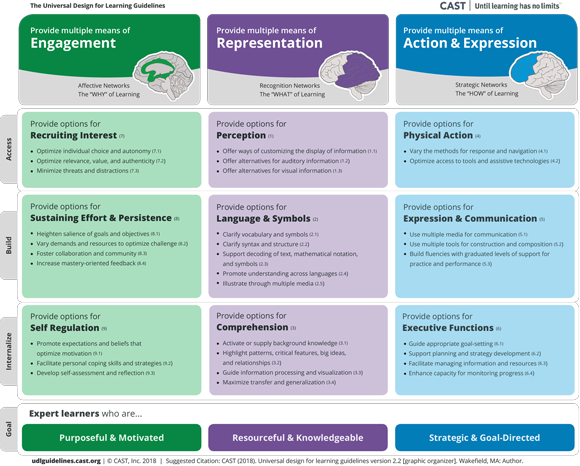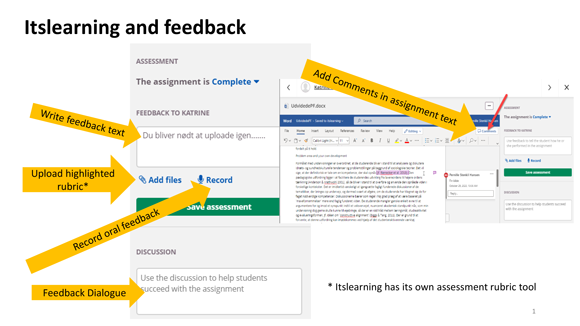
THEME: Including all students - Practical approaches
Practical approaches to planning and teaching inclusive and accessible courses.
- The aim of Universal Design for Learning (UDL) is to enable all students’ learning through inclusive and accessible course design, teaching and assessment (Burgstahler, 2021).
UDL has three principles:
- Engagement - why we learn
- Representation – what we learn
- Action and expression – how we learn
Table 1 provides an overview of UDL’s three principles and its accompanying guidelines:

Table 1. The Universal Design for Learning Guidelines 2.2 (CAST, 2018) - visit the link for an interactive version of the table
To illustrate how these three principles could be applied when planning and teaching a course, let’s look at each one in turn. To engage learners and captivate their interest in why they learn we can provide learning resources in a variety of formats, such as videos, slideshares or podcasts, academic articles, book chapters, reports, diagrams and tables. When teaching, we can aid comprehension and help clarify what the students are expected to learn by helping them see the big picture, setting them tasks which require them to make connections between different concepts and ideas. And we can help students understand how they learn by giving them different opportunities to act and express what they know using a wide range of technologies and active approaches to learning.
During the COVID-19 shutdown, maintaining wellbeing was a challenge for many students (Georgsen og Qvortrup, 2021). Here you can read how a highly flexible (HyFlex) course design which is modelled on UDL principles offers ways to maintain inclusive and accessible learning for all learners through online and blended learning courses.
- Making resources accessible for dyslexic readers. This PowerPoint-presentation (only in Danish), prepared by a student with dyslexia, provides a powerful insight into the barriers to learning they face and the additional time they have to spend tackling these barriers before learning becomes accessible.
- Assistive technologies is a catch all name for technological devices, software or programs which can enable learners to access teaching and engage with learning more effectively. You can read more about the range of assistive technologies and how they support learning on this JISC Blog . JISC is a UK organisation which provides a range of guides on inclusive and accessible online education. Some students will already use assistive technologies, or they may ask you to support their learning by using them. If you would like to know more about assistive technologies and how to use them, contact SDU Student Services. The Special Educational Support website https://www.spsu.dk/ from the Ministry of Children and Education (Børne- og Undervisningsministeriet) provides information about resources to support special educational needs.
- Microsoft has a website with accessibility guidance regarding Office 365, where you can access a range of videos showing how to make MS Word, Excel, PPT and Outlook emails more accessible. Even small adaptations can make textual, audial and visual resources more accessible. For example, the selection of fonts, text size, formatting and colour can all help make text more accessible and screen readers can ‘read’ images which have alternative text attached to them.
- itslearning has features, which can support accessibility. The template for designing courses has a clear hierarchical structure with Topics, Plans and the same sub sections within each Plan. By planning courses in this way, their design becomes familiar to the student and course components are clearly labelled making them more easily accessible. By going to the user profile settings, the user can choose the Accessibility option which includes a simplified tree structure, simple editor and scroll bars for all frames. itslearning is also compatible with some assistive technologies – you can read the full accessibility statement here .
An additional feature in itslearning is the variety of feedback options when a student uploads an assessment. Such variety illustrates how UDL principles can be put into practice, making feedback accessible in different formats. In the screenshot below, the feedback options are labelled and include a feedback comment box, uploading a file, providing feedback via a rubric, annotating the assignment if submitted as a word.doc or pdf file or recording audio feedback. Audio feedback gives the opportunity for expressing nuance through tone, which means we can reassure a student with an encouraging tone even if the feedback indicates significant editing and reviewing is needed. Also, we can often say more in a short time than we can write, which means it may be a time saving way for teachers to give thorough feedback. Audio feedback helps develop a dialogic connection between the teacher and student, and the student can reply to any feedback on itslearning using the Discussion box.
Audio feedback gives the opportunity for expressing nuance through tone, which means we can reassure a student with an encouraging tone even if the feedback indicates significant editing and reviewing is needed. Also, we can often say more in a short time than we can write, which means it may be a time saving way for teachers to give thorough feedback. Audio feedback helps develop a dialogic connection between the teacher and student, and the student can reply to any feedback on itslearning using the Discussion box.
- Watch three short videos where Ivan Newman, - ivan@dyslexiahandled.co.uk - PhD, a Specialist Study Skills Tutor in UK HE describes scenarios where students experienced barriers to learning which limited their engagement and their opportunities to learn and practical ways forward. Having identified the barriers to learning with the students, Ivan counselled the students on how the barriers could be replaced with inclusive approaches. By putting these inclusive approaches into action, the students’ opportunities to learn were improved and they were able to achieve the learning outcomes. The videos are in English with captions to facilitate access. Ivan is happy for the videos to be shared with teachers and students.
Video 1: "I feel left out"
Video 2: “Everyone speaks at once”
Video 3: “I cannot hold all the information in my head”